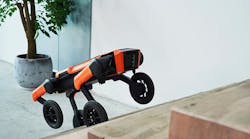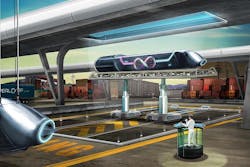Testing a motor may not seem like big news, unless it's the first step to a real life hyperloop.
The biggest gamble in Nevada isn’t happening in Las Vegas; it’s 30 miles north at Hyperloop One’s test track.
This week, by staging the first ever hyperloop electric motor test, the company laid down some great visual evidence to investors--and anyone looking forward to commuting around metropolises in a vacuum tube at 700 mph – that the project is more than a bluff.
In 2013, Elon Musk, founder of Tesla Motors and SpaceX, released a white paper detailing in 58 pages how to build super speedy, energy efficient transport for passengers and cargo that magnetically levitates in an elevated pneumatic tube system. He open-sourced the document because he’s too busy trying simultaneously to save and get the hell off the planet, with electric cars and rocket ships respectively.
By sending a 1,500-lb test sled down a half-mile track in less than 5 seconds, the former Hyperloop Technologies (a merciful name change to differentiate itself from competitor Hyperloop Transportation Technologies) took the first of what will be many steps to develop a working hyperloop.
Hyperloop One is confident they can get there, possibly by 2020, asserts co-founder Shervin Pishevar.
“The engineering is already done. We know that it works. What we’re driving for is our Kitty Hawk moment, when people actually see it.”
Musk, who is building a test track in Texas for hyperloop car prototypes, also appeared to like what he saw:While it’s clearly hyperbole to compare technology used at amusement parks to the first flight of Orville and Wilbur Wright, you can’t fault Pishevar for being confident. And that confidence seems to have worked on the people who really count – the investors. The team initially raised $20 million, and has coaxed $80 million from investors in the second round. France, hoping to use the technology for public transportation, is one of the investors.
Meanwhile, competitor HTT is planning an urban loop around a proposed sustainable city in central California. While Hyperloop One has peppered tech blogs with soundbites about Kitty Hawk and “moon shots,” this is hardly an Americans-vs.-Soviets space race.
Will the hyperloop transcend the limitations of modern transportation? We'll find out.
Illustration: Hyperloop One
Maybe this is the Sputnik moment, though. It took 12 years for humans to get to the moon from that point, and that was using the computing power of a Gameboy. With some of the world’s most ambitious engineers and tech giants on the job, 2020 might not seem that crazy for a working version somewhere. And maybe by 2030, you really can go from L.A. to San Fran in 30 minutes.
“When you think of Hyperloop, you think maybe this is going to happen years from now,” says Rob Lloyd, Hyperloop One’s new CEO (and former CISCO president. “It’s going to happen much quicker than anyone imagines. When it does, the world will never be the same.”











